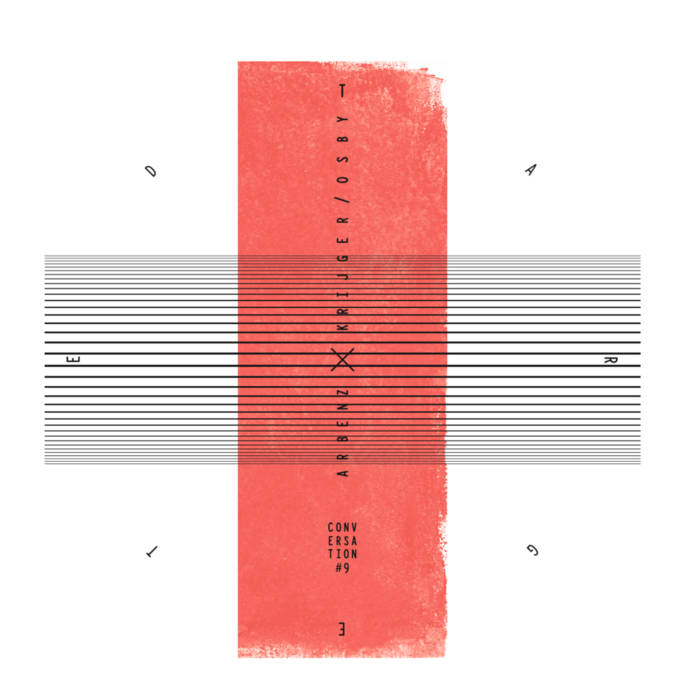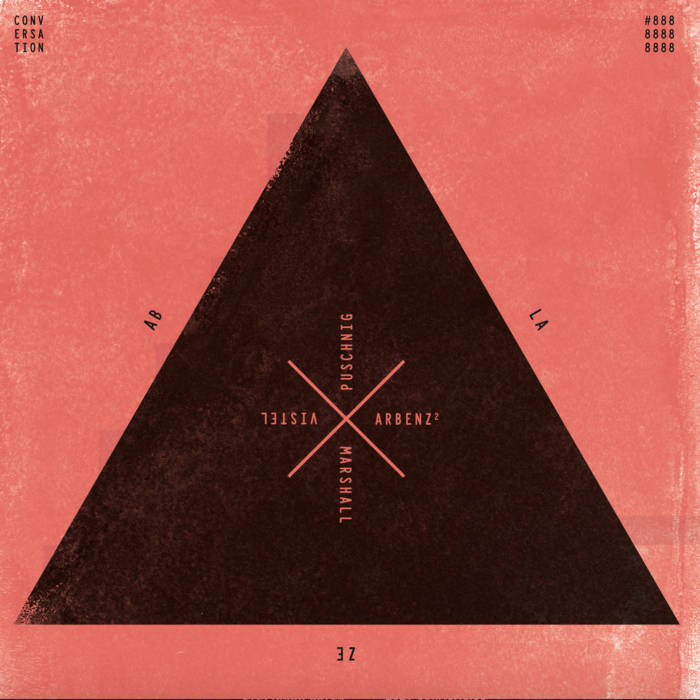Florian Arbenz Conversation 10
Florian Arbenz Conversation 10
Release Date: 08.09.2023
Florian Arbenz – Drums, Percussion
Martial In-Albon – Trumpet, Flugelhorn, Sea Shell
Rafael Jerjen – Bass
Nils Wogram – Trombone
Christy Doran – Guitar
Matthias Würsch – Glass Harmonika (Track 4)
“Was eine Besetzung”
“Florian Arbenz ist kein Musiker, der sich damit zufrieden gibt, still zu sitzen, wie sein ehrgeiziger Plan, zwölf Alben mit zwölf völlig unterschiedlichen Ensembles aufzunehmen, deutlich zeigt. Der zehnte Teil seiner “Conversations”-Serie, “Inland”, wird am 8. September bei Hammer Recordings erscheinen.
Während der Coronavirus-Pandemie gab es eine Zeit, in der Schweizer Musiker nur mit Musikern innerhalb ihrer Grenzen arbeiten und auftreten durften. Arbenz nutzte diese restriktive Situation, um mit einigen seiner Lieblingsinstrumentalisten aus der Schweizer Szene in Kontakt zu treten” [ Bandcamp]
Ungeheuerlich, atemberaubend, ausgezeichnet, Superlativ neben Superlativ, Unglaubliches kommt da aus den Mundstücken von Nils Wogram und Martial In-Aborn, genauso überraschend, was Christy Doran an der Gitarre beimischt oder aus seinen Geräten herauszieht – die erste Assoziation war Mangelsdorff meets James Blood Ulmer, nun sind das weder Mangelsdorff noch Ulmer, es sind leibhaftig hör- wie spürbare Musiker einer eigenen Liga. Ein ekstatischer Rausch, ein Wogram in Höchstform, ein Alborn in Höchstform, ein Doran in Höchstform. Fehlen noch Jerjen und Arbenz am Bass und Schlagzeug. In Top-Form. Als I-Tupfel gibt es noch eine Glass-Harmonica in Stück vier von Matthias Würsch oben drauf.
Du kannst das Eingangsstück Jammin nicht oft genug hören. Das sind Schlagwerk mit Posaune, ebenfalls als Schlagwerk, möchte man meinen und erst dann Posaune. Erinnert an den Rusty Bagpipe Boogie aus 2010, meine Güte, auch schon 13 Jahre her. Muss man das explizit erwähnen? Braucht es dafür noch Worte? Bei diesen Tönen.
Kann sich Nils Wogram noch erinnern, mit wem er wann welche Aufnahmen vorgenommen hat und wenn ja, wie viele? – erinnert sich Martial In-Albon noch, mit wem alles er die vielen Aufnahmen gemacht hat? Gleiche Frage geht an Christi Doran und blicke ich Rafael Jerjen über die Schulter, möchte ich gleich nochmal nachfragen – weiß Florian Arbenz noch, wie häufig er in seinem Leben den Freedom Jazz Dance von Eddie Harris gespielt hat. Eins kann man schon jetzt sagen: die vorliegende Aufnahme Conversation #10, Urheber ist der unermüdliche Schlagzeuger Florian Arbenz aus der Schweiz, genauer Basel, setzt bei schon neun vorliegenden Aufnahmen, gleich nochmal einen oben drauf.
Es sind die beiden ruhigen Stücke, Moon Song und Chant, die das Gesamtwerk zu etwas Besonderem machen, die Wechsel zwischen Ruhephasen und stürmischen Anliegen sind so raffiniert aufeinander abgestimmt oder ineinander verzahnt – die Gesamtaufnahme hörst du einmal, zweimal, dreimal, und bist noch immer nicht fertig mit ihr. Ob das nun Dekonstruktion ist, PostBop oder rasende Musik, ob das Fragmente neu zusammengesetzt oder Neuinterpretationen von Standards sind, ob das nun eine Session ist oder ein Gesamtkunstwerk aus sich selbst heraus – diese Fragen scheinen nicht mehr relevant, was du hörst, ist: Musiker spielen in ihrer eigenen Liga und reißen Konventionen ein wie auf, setzen ihre eigenen nicht erwartbaren Akzente, spielen sich entlang der eigenen Arrangements in einen rasenden Raum, alles dreht sich und wird neu. Bekommt einen eignen Sound.
Wieder höre ich Jammin. Die Multiphonics im flotten Swing. In Sound, Stück 2, haben wir eine Mischung aus Trompete und Posaune – die sich ihre eigenen Multiphonics jeweils zuschieben, was besonders hervorsticht, ist auch die multiphone Rhythmik, die Schlagzeug und Bass im Hintergrund dem Ganzen unterlegen. Eine Multiphonic-Infektion geht reihum sozusagen. Und wenn erst die Gitarre dazu kommt, ist es um den einen Raum geschehen, es werden ungleich viele Räume – Gitarre, Trompete und Posaune intonieren die gleiche Melodie – was wie ein Mehrschichtenmodell an Sound klingt und wunderbar aufgelöst im Solo von Doran landet, der dort seinerseits ein multiphones Brennglas eröffnet – wer nun glaubt, es ginge hierbei nur um Klangspiralen oder diaphonisches Überdrehen oder um überspitzte Obertöne, wird in Connecting überrascht, da es zum Duell kommt zwischen Schlagzeug und Gitarre.
Die Aufnahme eilt von Höhepunkt zu Höhepunkt und bekommt in Moon Song eine extra Portion, herbeigeführt durch die Glasharmonika – die diaphonen Multiphonics tauchen ab in den ureigenen idiophonen (selbsttönenden) Sound der Glasharmonika – wundervoll arrangiert, subtil zusammengeführt und schön aufgezogen, wie das Schlagzeug mit einem Tusch den Raum für die Posaune freiwischt.
Bei so vielen Höhepunkten droht gleich auch der Absturz – könnte man meinen. Von wegen. Wie bei den anderen Aufnahmen auch, folgt der Freedom Jazz Dance. Nochmal die Frage: In wie vielen Kombinationen haben wir den Freedom Jazz Dance? Meine Zählung kommt auf acht Freedom Jazz Dance Varianten, Ideen oder Ansätze – es sind die Freedom Jazz Dances zusammengezählt eine eigene Aufnahme –
Abgeschlossen wird das Album mit Fast Lane, wie der Titel sagt, mit einem schnellen Stück, so, als hätten sie ein Ohr für dramaturgische Entwicklungen, am Ende raus mit dem vom multiphonen Brennglas entflammten Studio – es ertönt ein letzter großer Akkordstoß – und. Was und? Nun. Jammin hieß das erste Stück, gleich nochmal – das ist wie Springen vom Zehnmeterbrett, du kriegst nicht genug davon, erst wenn der Pförtner kommt, der Gärtner oder der Platzwart, der Salonreiniger, der mit dem Netz – wie die da raus gehen – Baddam. Punkt. Lass das erst Nachhallen. Baddam. Punkt. Aus.
Bitte das Ganze noch mal, von vorn, bitte. Alles. Die ganze Scheibe. Gehört zum Besten, was dieses Jahr hergibt. Glaub mir.
Florian Arbenz Conversation 10 – english version
Florian Arbenz is not a musician who is content to sit still, as his ambitious plan to record twelve albums with 12 drastically different ensembles clearly indicates. The tenth instalment of his ‘Conversations’ series, ‘Inland’, is set to release on September 8th on Hammer Recordings.
During the Coronavirus pandemic, there was a period of time where Swiss musicians were restricted to working and performing solely with musicians within their borders. While restrictive, Arbenz turned this situation into an opportunity to connect with some of his favourite instrumentalists on the Swiss scene
Outrageous, breathtaking, excellent, superlative next to superlative, unbelievable things come out of the mouthpieces of Nils Wogram and Martial In-Aborn, just as surprising what Christy Doran adds on the guitar or pulls out of his devices – the first association was Mangelsdorff meets James Blood Ulmer, now these are neither Mangelsdorff nor Ulmer, they are musicians of a league of their own, audible and perceptible in the flesh. An ecstatic rush, a Wogram in top form, an Alborn in top form, a Doran in top form. Jerjen and Arbenz on bass and drums. Also in top form. As an I-dot, there is a glass harmonica in piece four by Matthias Würsch on top.
You can’t hear the opening piece Jammin often enough. These are percussion with trombone, also as percussion, one would think, and only then trombone. Reminiscent of the Rusty Bagpipe Boogie from 2010, my goodness, also 13 years ago. Do we have to mention that explicitly? Do we still need words for that? With these sounds.
Can Nils Wogram still remember with whom he made which recordings and when, and if so, how many? – does Martial In-Albon still remember with whom he made all those recordings? The same question goes to Christi Doran, and looking over Rafael Jerjen’s shoulder, I want to ask again right away – does Florian Arbenz still know how often he played Eddie Harris’ Freedom Jazz Dance in his life? One thing can already be said: this recording, Conversation #10, by the indefatigable drummer Florian Arbenz from Switzerland, or more precisely Basel, takes the nine existing recordings to the next level.
It is the two quiet pieces, Moon Song and Chant, that make the complete work special, the alternation between quiet phases and stormy concerns are so cleverly coordinated or interlocked – you listen to the complete recording once, twice, three times, and you are still not finished with it. Whether it’s deconstruction, post-bop or frenzied music, whether it’s fragments reassembled or reinterpretations of standards, whether it’s a session or a total work of art in its own right – these questions no longer seem relevant, what you hear is: musicians playing in their own league, tearing down conventions as well as up, setting their own unexpected accents, playing along their own arrangements into a frenzied space, everything spinning and becoming new. Gets its own sound.
Again I hear Jammin. The multiphonics in brisk swing. In Sound, track 2, we have a mixture of trumpet and trombone – each pushing their own multiphonics towards the other. What is particularly striking is also the multiphonic rhythm that the drums and bass in the background underlie the whole thing. A multiphonic infection goes around, so to speak. And when the guitar joins in, the one room is gone, it becomes an unequal number of rooms – guitar, trumpet and trombone intonate the same melody – which sounds like a multi-layered model of sound and ends up wonderfully resolved in Doran’s solo, which in turn opens up a multiphonic burning glass – anyone who now believes that this is only about sound spirals or diaphonic over-twisting or exaggerated overtones is surprised in Connecting, as it comes to a duel between drums and guitar.
The recording rushes from climax to climax and gets an extra portion in Moon Song, brought about by the glass harmonica – the diaphonic multiphonics dive into the glass harmonica’s very own idiophonic (self-tinting) sound – wonderfully arranged, subtly brought together and beautifully wound up, as the drums clear the space for the trombone with a flourish.
With so many high points, one could be forgiven for thinking that there is a danger of a crash. But not so. As with the other recordings, the Freedom Jazz Dance follows. Again the question: How many combinations of Freedom Jazz Dance do we have? My count comes to eight Freedom Jazz Dance variations, ideas or approaches – it’s the Freedom Jazz Dances added up to a recording of their own -.
The album closes with Fast Lane, as the title says, with a fast piece, as if they had an ear for dramaturgical developments, at the end out with the studio ignited by the multiphonic burning glass – one last big chordal blast is heard – and. What and? Well. Jammin was the name of the first piece, right again – it’s like jumping off a ten-metre board, you can’t get enough of it, not until the gatekeeper comes, the gardener or the groundsman, the lounge cleaner, the one with the net – how they go out there – Baddam. Full stop. Let that resonate first. Baddam. Full stop. End.
Please, the whole thing again, from the beginning, please. All of it. The whole disc. One of the best this year has to offer. Trust me.
have a look for:
- Florian Arbenz Conversation 10
- Florian Arbenz Conversation 9 Targeted
- Florian Arbenz Conversation 8 Ablaze
- Florian Arbenz Conversation 6 und 7
- Florian Arbenz Conversation 5
- Florian Arbenz Conversation 4
- Florian Arbenz Conversation #2 und #3
- Florian Arbenz Conversation Condensed #1
- Florian Arbenz Groovy Vibraphon – Convergence
- Florian Arbenz drums




